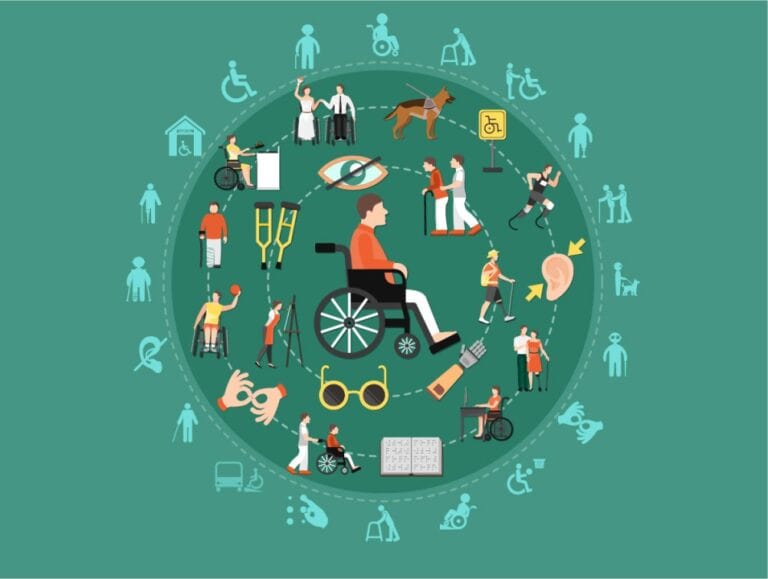We all live together influenced by our diverse backgrounds and experiences. One essential facet of this diversity is ‘disability’. There are various types of disabilities including physical, psychological, and sensory impairments that can influence an individual’s day-to-day life.
While the term “handicapped” is used sometimes, it is considered obsolete and can have unfavorable connotations. Rather concentrating on “disability” recognizing the challenges people deal with without any limitations is important.
Why Understanding Different Types of Disabilities Matters?
Recognizing the various kinds of impairments is vital for producing a truly diversified and supportive world. By valuing the distinct needs and experiences of individuals with disabilities, we can make sure that every person has the chance to grow.
Right here, we’ll discover a few of the common types of disabilities, their effect along with methods to develop a more accessible environment.
Types of Disabilities & Their Impact
Physical Disabilities
Physical disabilities refer to constraints in movement or body function. Some of the examples are:
- Mobility Impairments: Difficulty in walking or utilizing staircases.
- Amputations:Loss of an arm or leg as a result of injury or health problem.
- Paralysis:Loss of muscle functions in part of the body.
These types of disabilities can influence an individual’s capacity to do day-to-day tasks like clothing, showering, or going around. Ease of accessibility features like ramps, lifts, as well as larger entrances become an important part for independent living.
Intellectual & Developmental Disabilities
These disabilities influence cognitive functioning and flexible actions which are the abilities we require for daily life. Instances consist of:
- Down syndrome:A hereditary problem impacting advancement and learning.
- Autism Spectrum Disorder (ASD):It is characterized by social interaction difficulties as well as recurring actions.
- Intellectual Disability: A substantially below-average intellectual capability that influences everyday life.
People with these types of disabilities might require assistance with interaction, learning and social communication. They are capable of remarkable things; however require understanding and confidence to reach their full potential.
Sensory Disabilities
Sensory impairments influence several senses– sight, hearing, touch, taste or smell.
- Visual Impairments:It can vary from reduced vision to complete loss of sight. Individuals with reduced vision might need enhanced lighting or zoom in devices.
- Hearing Impairments:It can differ from deafness to difficulty of hearing. Listening devices, sign language as well as assistive listening gadgets can make interaction simpler.
People with sensory disabilities typically count on innovations and alternative interaction techniques to take part in their surroundings.
Chronic Illnesses and Health Conditions
Persistent health problems are short-term wellness problems that can impact an individual’s capability to work. Examples consist of:
- Diabetes:It affects how the body manages blood sugar level.
- Multiple Sclerosis:It is a condition that affects the nervous system.
- Cystic Fibrosis:A hereditary problem that impacts the lungs along with digestion system.
These types of disabilities call for recurring management and can influence mental and physical wellness. Recognizing these obstacles allows us to provide assistance and develop inclusive atmospheres.
Psychological Disabilities
These are mental health conditions that influence an individual’s reasoning, sensations and also behaviors. Some of the examples include:
- Depression:A state of psychological disorder defined by sensations of despair and also hopelessness.
- Anxiety Disorders: It includes excessive concern and uneasiness that can disrupt everyday life.
- Bipolar Disorder:A problem that triggers severe mood swings from frenzy to clinical depression.
Individuals with psychological types of disabilities usually encounter stigma and misconceptions. Making a supportive and understanding environment can be vital for their well-being.
Acquired Disabilities
Some disabilities are acquired later on in life usually because of accidents or ailments. These consist of:
- Traumatic Brain Injury (TBI):It is caused by a strike to the head that affects brain function.
- Spinal Cord Injury (SCI):Damage to the spine that can lead to paralysis and also various other problems.
People that get these types of disabilities later in life deal with the obstacle of adapting to a new reality. They might require consultation and assistance solutions to restore self-reliance and confidence
Inter-sectionality & Multiple Disabilities
It is essential to keep in mind that people with disabilities can experience a mix of health conditions. This is referred to as intersectionality.
For instance, a person with Asthma may additionally have Diabeties also. Recognizing these intricacies is essential to giving reliable assistance.
Types of Handicapped Disabilities
While “handicapped” is no more the recommended term it can be useful to understand the context of special needs. Below is a breakdown of physical and cognitive impairments in addition to the social and ecological obstacles encountered by people with these difficulties.
Physical Handicapped Disabilities
Physical handicaps describe constraints in physical working that can make it hard to execute day-to-day tasks or communicate with the setting. Some usual instances consist of:
- Limb Impairments:This can vary from missing out on arm or legs as a result of amputation to constraints in movement as a result of problems like arthritis or muscle dystrophy. Daily jobs like clothing, showering or making use of mass transit can become difficulty.
- Wheelchair Dependence:Individuals who depend on mobility devices like wheelchair for movement face unique challenges. Stairways, narrow entrances as well as absence of accessible restrooms can be substantial barriers.
Cognitive Handicapped Disabilities:
Cognitive types of disabilities describe constraints in cognitive performance, which can influence areas like learning, memory, analytics, and communication. Right here are some typical instances:
- Learning Disabilities:These are neurological problems that impact specific areas of learning such as reading, writing or mathematics. People with learning impairments might battle with typical training approaches together with need customized assistance.
- Memory Impairments:These can vary from moderate lapse of memory to problems like mental dementia. Remembering instructions, adhering to routines and also handling funds can come to be testing.
Social & Environmental Barriers
Both physical as well as cognitive types of disabilities can cause social and environmental obstacles that restrict a person’s capability to involve completely. Some usual obstacles include:
- Inaccessible atmospheres:Buildings without ramps, lifts, or accessible restrooms can be physically impassable.
- Lack of transportation:Public transport systems that are not geared up for mobility devices or various other movement aids can restrict accessibility to work, college, as well as social tasks.
- Communication problems:Individuals with cognitive or speech disabilities might have a hard time to interact properly, resulting in social seclusion and misconceptions.
- Negative mindsets: Stigma and false impressions concerning impairments can produce a feeling of exemption and limit possibilities.
Overcoming the Barriers
Fortunately, there are numerous means to conquer these obstacles and create a much more comprehensive atmosphere for every person.
Below are some examples:
- Designing physical spaces along with items that are usable by everybody regardless of capability can make a significant difference.
- Tools like screen readers, audio books, and interaction gadgets can equip people with cognitive or sensory disabilities.
- Educating the general public regarding various types of handicapped disabilities as well as nurturing compassion can aid break unfavorable stereotypes.
- Providing accessibility to rehabilitation, skills training, together with assistance groups can equip people with disabilities to live independently and also reach their full potential.
Embracing Diversity & Inclusion
By creating accessible environments, supporting for the legal rights of people with types of disabilities, and also promoting shared understanding, we can develop a world where every person has the possibility to prosper. Here are some means you can contribute:
- Learn regarding various sorts of impairments and their needs.
- Speak up against mistaken beliefs and also promote understanding.
- Offer assistance and aid when required.
- Support plans that promote accessibility as well as inclusion.
- Recognize as well as value the one-of-a-kind capabilities of individuals with impairments.
The Bottom Line
Recognizing types of disabilities is a continuous journey. By accepting diversity and inclusion, we can create a world where everyone feels valued, sustained and empowered. Keep in mind, impairment does not define an individual. It’s simply one facet of life experience. Let’s create, cherish & work together for a world that’s unique & embraces diversity of all kinds.



